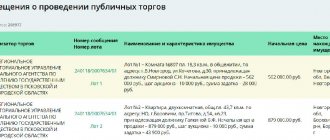The state guarantees the inviolability of private property. At the same time, one of the effective mechanisms for securing obligations is liability with all owned property. It is implemented by foreclosure and covering debts with the proceeds. The debtor's property is all tangible and intangible objects of civil rights that he owns that can be alienated. Including money, securities, land, accounts receivable. Seizure of property has its own specifics, which is explained by the category of property, the essence of obligations, the amount of debt, and the status of the debtor. There are direct prohibitions prescribed by law. Restrictions apply for individual properties. How to exercise your right without breaking the law? Legal offers professional legal support for legal relations and disputes. Foreclosing on property is an extreme measure, confirming that it is not enough to win the court and have a decision in your favor - it is important to confidently and competently go through the stage of enforcement proceedings.
Foreclosure system
Foreclosing on the debtor's property includes several steps or stages. First, a seizure is imposed on property in general or a specific object. At the second stage, an inventory is made and a seizure is made. The third step is the assessment of the debtor’s property. For this purpose, experts may be involved if we are talking about expensive objects. The next task is to resolve the issue of transferring property for storage and ensuring its integrity. Fifth, the property is sold. At the final stage, the collector receives the debt due to him or part of it. The issue of mutual offset of homogeneous claims can also be resolved. That is, foreclosure is a long, multi-stage process associated with procedural delays. To seize certain objects, the competence of the bailiff is not enough and a court decision is required. Certain categories of property are not subject to sale under any circumstances. In this context, it is important that a competent legal assessment of the situation is given, risks and prospects are analyzed, and a behavior strategy is developed.
The procedure for collecting the debtor's property
The algorithm of actions includes the seizure of property in the amount necessary to satisfy the claims of creditors, including costs and expenses for the procedure. The principle of reasonableness and expediency applies. Next comes the implementation. It can be voluntary, that is, the debtor himself sells the object of right, or compulsory - by organizing an auction by the bailiff. The procedure for foreclosure on the debtor's property assumes that the owner has the right to indicate those items that he wishes to include in the inventory in the first place. In this case, the final list is compiled by the bailiff. If the pledged property is collected according to a notary’s writ of execution, such objects are transferred to the pledgee for subsequent sale, taking into account mortgage legislation. In the case of common property, foreclosure on the debtor's property is carried out only in that part that is equivalent to his share. In an effort to quickly close proceedings, bailiffs may miss important things and thereby harm the parties. Therefore, it is recommended to be accompanied by a lawyer.
Sequence rules
The order of foreclosure on the debtor’s property is strictly specified by law:
- cash in rubles;
- funds in foreign currency;
- valuables on deposits, accounts, stored in banks, including precious metals;
- property owned, under operational management or economic management;
- objects and things owned by the right of common shared ownership.
When foreclosure on wages and other income, the maximum percentage of withholding is 50. The limit does not apply to such categories of payments as alimony, compensation for damage from a crime, compensation for harm due to the death of the breadwinner. In such situations, the maximum is 70%. In addition, the order of collection in enforcement proceedings allows you to take into account income such as unemployment benefits. Violation of the sequence allows you to appeal the bailiff's decision. Each subsequent queue is available only if the property in the previous one is insufficient or does not exist.
Providing property information
The procedure for foreclosure on the debtor's property presupposes that the bailiff is provided with comprehensive information about the available funds, movable and immovable property by the owner himself. To establish the property status, the bailiff requests from banks, credit organizations and tax authorities information about the numbers and types of bank accounts, funds in foreign currency and rubles, as well as other valuables. Similar actions can be carried out to request information about real estate and vehicles from the relevant government agencies. Legal entities have seven days to respond from the day the request is received. Until the debtor proves otherwise, the bailiff legally believes that all movable property located in the premises or other fenced area owned by such a person is his property. Consequently, foreclosure on such property of the debtor is presumed. Evidence to the contrary may include receipts and documents indicating the buyer.
Land foreclosure
Land plots are one of the most expensive objects. However, the law significantly limits the possibility of selling them against debt. The peculiarity of foreclosure on such property of the debtor when enforcement proceedings are carried out is that a court decision is required. This is a claim proceeding carried out as part of a civil or arbitration process. The corresponding demand can be submitted to the court by persons who are directly interested in this compulsory measure. We are talking about the bailiff and collectors. At the same time, persons whose interests may be directly affected by the sale of land should be involved in the process. This is relevant in cases where the plot belongs to the debtor, and the building on it belongs to another person. If the claim is satisfied by the court, the land is subject to assessment and an opinion is obtained. The implementation of this object in practice is associated with many nuances and difficulties. Legal offers comprehensive support for the procedure to guarantee its transparency.
Sale of a share in joint ownership
The priority of collection in enforcement proceedings suggests that the sale of the debtor's share in joint or shared ownership is possible only if there are no other options. A prerequisite is the involvement of all co-owners in the process. Without their participation, it is impossible to allocate a share in kind, which creates a barrier to the further algorithm of actions. If the allocation is impossible due to the individual characteristics of the object or there is no consent of the remaining owners, the issue of specifying the size of the share owned by the debtor is resolved. The interested shareholder has the right of first refusal to buy out part of the debtor at a cost that is commensurate with the market price. Violating the procedure for notifying other owners and holding public auctions at which the property was sold to third parties is contrary to the law. The right of co-owners on their initiative can be restored. A bailiff or a recoverer may initiate consideration in court of an application to change the method of execution of a court decision and use the features of foreclosure on the property of legal entities.
Enforcement proceedings for foreclosure
The law firm ZASCHITA quite often carries out orders for conducting enforcement proceedings . The most difficult is enforcement proceedings , during which it is necessary to foreclose on the mortgaged property under a mortgage agreement. A mortgage is a security against real estate. If the debtor took out a loan and mortgaged his apartment, the one who gave the loan has the right of mortgage (mortgage of real estate). If the debtor does not pay, the creditor can foreclose on the mortgaged property. at what the process of foreclosure on mortgaged property is in this article.
To begin with, let us outline the final goals of enforcement proceedings to foreclose on mortgaged property . Enforcement proceedings in this case can end in two ways:
1. The investor holds in his hands an extract from the Unified State Register of Real Estate on the state registration of the right to the subject of mortgage.
2. The investor holds in his hands the money received from the sale of the mortgaged property.
These are the goals of the work. Let's consider all the stages of achieving them.
Submitting a writ of execution
As a general rule, a writ of execution must be filed at the place of residence of the debtor. In most cases, it coincides with the subject of the mortgage. However, a situation is possible in which the subject of the mortgage is located in one area, and the place of residence of the debtor is in another. In this case, it should be submitted at the location of the subject of the mortgage, adding to the application a reference to clause 1 of Art. 33 of the Federal Law on Enforcement Proceedings, according to which “if the debtor is a citizen, then enforcement actions are carried out and enforcement measures are applied by the bailiff at his place of residence, place of stay or location of his property.”
Having determined the district department of the FSSP, you should prepare an application for acceptance of the writ of execution for enforcement.
The application must indicate
— Name of the district bailiff department
— Full name of the claimant and his address
— Full name of the debtor and his address
— Please accept the writ of execution and initiate enforcement proceedings
— Details of the writ of execution
— If the debtor has paid any amounts after the court decision, an indication of the fact of payment
— Bank details of the claimant
— Request to impose a temporary restriction on the debtor’s departure from the Russian Federation
— Request to seize the debtor’s property, indicating the subject of the mortgage. The attachment to this application must include
— Original writ of execution a (a copy must remain in our case files) — Copy of loan agreements — Copy of mortgage agreement
— A copy of the court decision or ruling
— A copy of the representative’s power of attorney (show the original upon submission)
This application for acceptance of the writ of execution for enforcement must be submitted in two copies. One must be handed over to the FSSP department. On the second, the office puts a mark of acceptance. This ends this stage.
Initiation of enforcement proceedings
After 5-7 working days from the date of filing the application, you must go to the office during the bailiff’s office hours and find out which bailiff your case has been transferred to. If it has not yet been transferred, clarify the transfer deadlines. If transferred, you should immediately go to an appointment with a bailiff and receive a decision to initiate enforcement proceedings .
First communication with the bailiff
During your first conversation, you should do the following:
— Check the direction of requests for property availability. Interested in Rosreestr, State Traffic Safety Inspectorate, Federal Tax Service regarding salaries, Pension Fund, if there is evidence that the debtor receives a pension.
— Check the direction of the request for voluntary execution of the court decision.
— Offer assistance in terms of providing transport, preparing documents, providing security and witnesses.
- Offer to include the request for receiving F7 and F9, as well as to deliver a response to this request (if it is possible to obtain F7 and F9 on your own, these documents should already be submitted by the first communication with the bailiff).
— Indicate that you are ready to provide a custodian for the seized property.
— Propose and agree on a plan for further action.
The first communication should end with an agreement on the next step. The next step should be to receive a response from Rosreestr about the debtor’s rights to real estate, as well as a request for F7 and F9 (if it is impossible to obtain independently).
Receiving a response from Rosreestr
The bailiff must send a request to Rosreestr to obtain information about the existence of the debtor's registered rights to real estate. A response must be received from Rosreestr indicating real estate objects and registered encumbrances, in particular mortgages. Next, you should negotiate with the bailiff about the inventory and seizure of the mortgaged property.
Obtaining F7 and F9 (if it is impossible to obtain independently)
The issue of obtaining Form 7 and Form 9 for the mortgage should be resolved with the bailiff. It is necessary to invite the bailiff to issue the corresponding request in hand and immediately receive these documents from the settlement and registration department at the location of the subject of the mortgage. If the bailiff indicated that he will do this himself, it is necessary to clarify the deadlines for completion.
Inventory and seizure of pledged property
At this stage, it is necessary to obtain agreement from the bailiff on the shortest possible time for drawing up the inventory and arrest. It is advisable to carry out this event without actually visiting the debtor’s site. If it is necessary to leave, the bailiff should be provided with the presence of witnesses and transport. The end of this stage is the receipt of an act of seizure (inventory of property).
Conclusion of a storage agreement free of charge
During subsequent meetings with the bailiff, it is necessary to indicate that we have a person who is ready to enter into an agreement for the storage of mortgaged property free of charge and to act as a custodian. The bailiff should provide the custodian’s passport details and clarify when he will be able to send them to the main department. The bailiff must send the custodian's data and information about the subject of the mortgage to the Main Directorate of the FSSP at the address: st. Bolshaya Morskaya, no. 59. (for the Leningrad Region Bolshoy pr. V.O., no. 80, lit. B). A specific employee is responsible for drawing up the storage agreement. 3 days after the district bailiff sends the data to the Main Directorate, it is necessary for our custodian to call a specific employee and coordinate the time of arrival to sign the storage agreement. The mortgage collector's representative must review the execution of the custodian's custody agreement.
Transfer of seized property to auction
It is necessary to obtain a resolution from the bailiff to transfer the seized property for auction, which is addressed to the FAUGI Territorial Administration of the Federal Property Management Agency in the Leningrad Region. A bid application must also be submitted. These documents must be sent to the Main Directorate. It is necessary to check the fact that the case was sent from the district department of the FSSP, since the issuance of a decision does not yet mean the actual transfer of the case. From the main department of the FSSP, the case should be sent to the Federal Property Management Agency. The result is a notification that the seized property is ready for sale.
Preparation of tenders
The Federal Property Management Agency must transfer the object for bidding to one of the commercial organizations. The result is the issuance of an Order for the provision of services for the sale of seized property at auction. Next, the selected commercial organization must publish a message about the auction on the website https://fssprus.ru/torgi/. Bidding information must be checked at least once every two weeks. The search is best done using the original sale price of the mortgaged property. When information about the date of the auction becomes available, the director and investor should be notified.
Bidding
After the end of the primary or secondary trading date, you should check their results on the website https://fssprus.ru/torgi/. If the information does not appear on the website for more than a week, it is necessary to visit the district bailiff to obtain information. As a rule, the first auction is considered invalid. In this case, it is necessary to track the date of secondary trading. Repeated auctions may also be declared invalid. However, they can happen. Let's consider options in both cases.
The auction took place. Receiving funds
In this case, you need to make sure that the bailiff has the details of the collector to send funds. However, it should be understood that after the buyer pays money to the auction organizer, these funds go to the accounting department of the Federal Bailiff Service. It may take about one month until the proceeds are transferred to the claimant. You should track the receipt of money into the creditor's account. If necessary, arrange access to the bailiff leading the enforcement proceedings .
The auction did not take place. Leaving property behind
If the repeated auction for the sale of the pledged property does not take place, it is extremely important to timely declare your consent to retain the property in the manner provided for in clause 4. Art. 58 Federal Law “On mortgage (real estate pledge)”. According to the norm of this law, the claimant-mortgagee may choose to acquire ownership of the mortgaged property. The price in this case will be determined by the formula: the price of real estate at the first auction - 25%. That is, if at the first auction the apartment was offered at a price of 4,000,000 rubles. At the second auction, the price is reduced by 15% (in this case, the price at the repeated auction will be RUB 3,400,000). And if the re-tender does not take place, the price at which the property can be retained will in this example be 3,000,000 rubles. At the same time, the claimant-mortgagor can use the offset to purchase this real estate. That is, if by the end of the repeated auction the total amount of the debtor’s debt (including all interest, fines, expenses) exceeded the amount of the initial sale price minus 25%, then the debtor does not need to pay anything through the bailiff service. You can simply declare that you retain the property, and the debtor will still owe the difference between the total amount of debt and the price of retaining the property. If the amount of the total debt is lower than the price of abandonment of the property by the mortgagee-collector, then the debtor will have to pay the difference between the price of abandonment and the total amount of the debt. When conducting enforcement proceedings to foreclose on the pledged property, it is necessary to calculate in advance what the amount of debt of the mortgagor-debtor will be by the end of the repeated auction. Ideally, the amount owed should be greater than the price of reserving. In this case, no additional payments will be required. When retaining mortgaged real estate, it is extremely important to comply with the deadlines established by law. In accordance with paragraph 5 of Art. 58 of the Federal Law “On Mortgage (Pledge of Real Estate)”, the claimant can retain the pledged property only within one month from the moment the repeated public auction is declared invalid. If this deadline is missed, the pledge of real estate is terminated. In fact, this will mean the impossibility of collecting the debt. In this case, it is extremely important to receive a notification from the bailiff as soon as possible after the repeated auction with a proposal to retain the property that was not sold at the auction. After receiving this document, you should immediately send to the bailiff and the auction organizer an application to reserve the mortgaged real estate. Also, the bailiff must submit a calculation of the debt of the debtor-mortgagor on the date of leaving the property behind. This is especially true if the writ of execution indicates an open amount of interest and penalties.
The text of the application to reserve the pledged property may be as follows:
STATEMENT
On the retention of the debtor’s property that was not sold during the execution of the writ of execution.
Based on the claim of the Claimant... dated 08/06/2015, enforcement proceedings were initiated No. 74835/15/78024-IP dated 08/14/2015, the bailiff was Alexandra Vladimirovna Fedorova. Initiated on the basis of the writ of execution No. FS No. 006079718 dated 08/05/2015, issued by the Primorsky District Court in case No. 2-4283/2015, which entered into force on 07/28/2015, subject of execution: foreclosure on mortgaged property 1/3 share, by selling it at public auction, the sales price upon its sale in the amount of 1,300,000 rubles, in relation to the debtor: ..., ... year of birth, debtor's address: ... St. Petersburg, Russia, 197374, in favor of the claimant: ..., address of the collector: ... St. Petersburg, Russia, 197341.
On 05/12/2016, during enforcement proceedings ... represented by a representative by proxy... Notification dated 05/11/2016 No. 16/4507427 was handed over with a proposal to leave for... the following property: 1/3 share of an apartment at the address:... for 975,000 rubles ., since the specified property was not sold at public auction. For the claimant, this property is of interest and value, based on the above
ASK:
1. Accept the consent of the claimant... to leave the debtor’s property..., within the framework of enforcement proceedings No. 74835/15/78024-IP dated August 14, 2015.
Application:
1. A copy of the representative’s power of attorney.
2. Calculation of debt as of the date of application
This application must be submitted to the bailiff and the executor, putting an acceptance mark on the copy. Similarly, this application must be submitted to the auction organizer. At the same time, submitting an application to retain the unrealized pledged property should be submitted by mail. It is necessary to send registered letters to the auction organizer and the bailiff with acknowledgment of delivery. It is mandatory to draw up an inventory of the postal item and save the receipt for sending the letters.
Receiving from the auction organizer a set of documents for registering ownership of the pledged property
To register ownership of the pledged property, you must obtain the following documents from the auction organizer:
1. An order for the provision of services for the sale of seized property at auction (taken from the auction organizer, such as a power of attorney from Rosimushchestvo);
2. Printout from a periodical about the start of the first auction;
3. Protocol on the first auction;
4. Printout from a periodical about the start of re-tendering;
5. Protocol on re-tendering;
6. Notification of the auction organizer about the retention of the debtor’s property that was not sold during the execution of the writ of execution.
Receiving from the bailiff a set of documents for registering ownership of the mortgaged property
After submitting an application to the bailiff to retain the pledged property, you must agree with him on a day to receive the registration kit. To register ownership of mortgaged real estate that was not sold at the repeated auction, we need the following set of documents from the bailiff:
1. Resolution of the bailiff on the transfer of property for sale;
2. The act of transferring seized property for sale;
3. Resolution of the bailiff to reduce the price of property transferred for sale by 15%;
4. Notification of failed tenders;
5. Act of return of property to bailiffs from the auction organizer;
6. An offer to the claimant of unrealized property to retain the property;
7. Application for retention of the debtor’s property that was not sold during the execution of the writ of execution;
8. Resolution on the abolition of measures banning registration actions in relation to property;
9. Resolution on the transfer of unrealized property of the debtor to the claimant;
10. Resolution to lift the seizure of property by a bailiff;
11. The act of transferring unrealized property to the claimant.
After receiving sets of documents from the bailiff and from the auction organizer, the next stage begins - registration of ownership in Rosreestr for the mortgaged real estate. And we will talk about it in the next article.
Kuznetsov Mikhail Vladimirovich - General Director
LLC "Legal
What is not subject to implementation
The following cannot be confiscated for sale from a debtor-citizen:
- the only residence, including part of the premises, except when it is the subject of a mortgage;
- things from everyday life and ordinary home furnishings;
- money in an amount equal to the subsistence level for each family member;
- personal and children's belongings, clothing, except expensive jewelry;
- food products, if their volumes are not used in business activities;
- certain types of income, such as compensation for personal injury.
The peculiarities of foreclosure on the property of a debtor organization are that the seizure and sale of pledged property is prohibited from the moment the bankruptcy moratorium began to operate. A similar rule applies to money from special accounts for the formation of the capital property fund of apartment buildings. Foreclosure of leased items and property that belongs to the indivisible fund of agricultural cooperatives is prohibited.
List of property that cannot be foreclosed on under executive documents
Foreclosing on the property of a person obligated to pay alimony occurs if his total income (including hidden sources of profit) is not enough to pay off arrears of alimony payments. Only in this case can his debts be transferred to property values that belong to the debtor. In such a situation, the property will be subject to arrest and, if within the period established by law the debtor does not get rid of all his debts, then the property will be sold and the debt to the recipient of alimony will be repaid from the proceeds.
At the same time, it is worth noting that the treatment of debts on the property interests of the payer has some restrictions that relate to a specific list that is not subject to participation in the treatment process.
In accordance with current legislative standards, foreclosure on property cannot be carried out:
- If the alimony payer lives in a home that belongs to him on shared ownership and is his only real estate;
- For a car, if the debtor can prove that a car is not a means of luxury or a means of transportation for him, but the only source of income;
- For an apartment or house, if it is the debtor’s only valuable property;
- For land plots on which there are residential buildings, but which are not used for profit or as a site for commercial activities;
- Personal hygiene items, clothing and shoes, as well as household items (furniture, dishes, etc.), excluding luxury items and jewelry.
Author of the article
Features of foreclosure on real estate
Considering the specifics of such objects, they cannot be seized in the literal sense of the word. Therefore, the task of the bailiff is to create conditions under which it is impossible to dispose of such property. That is, an arrest is imposed, about which a corresponding decision is made in the presence of attesting witnesses and sent to the state registration authority. Additionally, restrictions on ownership and use may be introduced. Real estate becomes the last object of sale. Bailiffs often neglect this rule in order to quickly close the proceedings. Debtors may also be interested in such an outcome. The Federal Agency for State Property Management is involved in the implementation process. Within 10 days from the moment when the acceptance and transfer certificate of such property is issued, information about the auction must be posted on the information and telecommunications network. The peculiarities of foreclosure on real estate are the complexity of the procedure and the short deadlines, as well as the risk of selling at a reduced price.
The role of a lawyer in the foreclosure procedure
Enforcement of court decisions with the help of bailiffs in practice results in difficulties for debtors and collectors. Legal offers professional legal support for enforcement proceedings and procedures for foreclosure on property. This is an effective way to minimize risks and get out of the situation as profitably as possible. The lawyer gives a correct assessment of the prospects and compliance with the law, analyzes the purity of documents and actions, controls the process of arrest, inventory, seizure and sale of property. The last aspect is especially important. Specialists in the field act as representatives in relations with all structures, request a report on the progress of enforcement proceedings, and promptly respond to measures taken for implementation. Foreclosure of property is a complex and financially risky process. Therefore, it will not be possible to minimize risks on your own, without qualified help.
Judicial practice under Article 237 of the Civil Code of the Russian Federation
Determination of the Constitutional Court of the Russian Federation dated January 29, 2019 N 219-O WITH
THE PROVISIONS OF ARTICLES 237 AND 845 OF THE CIVIL CODE OF THE RUSSIAN FEDERATION AND ARTICLE 110 OF THE FEDERAL LAW “ON EXECUTIVE PROCEEDINGS” The Constitutional Court of the Russian Federation composed of Chairman V.D. Zorkin, judges K.V. Aranovsky, A.I. Boytsova, G.A. Gadzhieva, Yu.M. Danilova, L.M. Zharkova, S.M. Kazantseva, S.D. Knyazeva, A.N. Kokotova, L.O. Krasavchikova, N.V. Melnikova, Yu.D. Rudkina, O.S. Khokhryakova, V.G. Yaroslavtseva,
Determination of the Constitutional Court of the Russian Federation dated April 25, 2019 N 941-O
1. Citizen T.Sh. Ilyasov challenges the constitutionality of paragraph 1 of Article 237 of the Civil Code of the Russian Federation, according to which the seizure of property by foreclosure on it for the obligations of the owner is carried out on the basis of a court decision, unless a different procedure for foreclosure is provided for by law or agreement.
Ruling of the Supreme Court of the Russian Federation dated November 20, 2017 N 305-ES17-16958 in case N A40-103809/2015
Guided by Articles 210, 235, 237, 309, 359, 360 of the Civil Code of the Russian Federation, Articles 21, 34, 39 of the Code of Inland Water Transport of the Russian Federation, Resolution of the Moscow Government dated September 26, 2013 N 641-PP “On approval of the Regulations on the organization of work on liberation of water bodies located on the territory of the city of Moscow from objects not registered as a vessel,” taking into account the conclusions of the examinations carried out in the case, recognizing as confirmed the costs of dismantling, transportation and storage of the object in the amount of 12,660,250 rubles 99 kopecks, the courts recovered from the company "Finance Grad", obliged to bear the burden of maintaining its property, the named expenses, foreclosure on the debtor's property.
Determination of the Judicial Collegium for Civil Cases of the Supreme Court of the Russian Federation dated November 21, 2017 N 19-КГ17-25
Refusing to satisfy the demands of Samoilov S.E. on the recognition of his right of ownership, the court of first instance proceeded from the fact that the plaintiff did not provide evidence that the actions (inaction) of the bailiffs of the Essentuki city department of the Federal Bailiff Service for the Stavropol Territory in the execution of the judicial act of April 2, 2009 were recognized as illegal, as well as evidence of the plaintiff’s ownership of real estate lost by him on the basis of a court decision by foreclosure on him for the obligations of the owner (Article 237 of the Civil Code of the Russian Federation).
Ruling of the Supreme Court of the Russian Federation dated January 13, 2020 N 306-ES19-24662 in case N A65-15224/2018
When considering the dispute, the courts were guided by Articles 237, 278, 353, 460 of the Civil Code of the Russian Federation, Articles 68, 69, 87, 94 of the Federal Law of October 2, 2007 N 229-FZ “On Enforcement Proceedings” and proceeded from the fact that society, being the owner of the specified property has a debt to the company on the basis of a court decision that has entered into legal force; the possibility of selling property is directly related to foreclosure on it only on the basis of a court decision; This claim was filed before the date of introduction of the surveillance procedure against the company.







